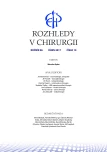Complicated intraabdominal infections in surgical patients–empiric antimicrobial therapy management
Authors:
F. Vyhnánek 1; V. Adámková 2,3
Authors‘ workplace:
Traumatologické centrum FN Královské Vinohrady, Praha
vedoucí lékař: doc. MUDr. F. Vyhnánek, CSc.
1; Ústav lékařské biochemie a laboratorní diagnostiky VFN, Praha
přednosta: prof. MUDr. T. Zima, DrSc., MBA
2; Ústav lékařské mikrobiologie LF Univerzita Palackého, Olomouc
přednosta: prof. MUDr. M. Kolář, PhD.
3
Published in:
Rozhl. Chir., 2017, roč. 96, č. 10, s. 405-410.
Category:
Review
Overview
Any intraabdominal infection (IAI) is a complex disease that requires an assessment of a number of various aspectsimportant for determining proper therapeutic management, including an appropriate antimicrobial regimen. Current classifications of intraabdominal infections recognize various types of peritonitides (primary, secondary, tertiary); however, for clinical needs the cases are most commonly divided as non-complicated and complicated intraabdominal infections. In any intraabdominal infection, the surgical intervention includes perioperative empiric choice of antibiotics, which should take into account – in addition to the severity level of the infection – the epidemiological situation and risk factors of the presence of resistant bacteria in the patient. The article presents a current overview of the choice of antimicrobial agents indicated in individual groups of intraabdominal infections (biliary, extrabiliary) caused by community-acquired or hospital-acquired pathogens. Recent guidelines for choosing antimicrobial drugs against multiresistant bacteria provide very important information, particularly with respect to the increasing incidence of multiresistant strains as causal agents of intraabdominal infections in surgical patients. However, surgical departments need to be familiar with current sensitivity of pathogens in order to provide individualized antimicrobial therapy via empiric administration.
Key words:
intraabdominal infection − multiresistant bacteria − antimicrobial therapy
Sources
1. Sartelli M, Weber DG, Ruppé E, et al. Antimicrobials: a global alliance for optimizing their rational use in intra-abdominal infections (AGORA). World J Emerg Surg 2016;11:2−32.
2. Sartelli M, Viale P, Catena F, et al. 2013 WSRS guidelines for management of intra-abdominal infections. World J Emerg Surg 2013;8:3.
3. Blot S, De Waele JJ, Vogelaers D. Essentials for selecting antimicrobial therapy for intra-abdominal infections. Drugs 2012;72:17−32.
4. Solomkin JS, Ristagno RL, Das AF, et al. Source control review in clinical trials of anti-infective agents in complicated intra-abdominal infections. Clin Infect Dis 2013;56:1765−73.
5. Sartelli M. A focus on intraabdominal infections. World J Emerg Surg 2010;5:1−20.
6. Eckmann C, Dryden M, Montravers P, et al. Antimicrobial treatment of “complicated“ intra-abdominal infections and the new IDSA guidelines– a commentary and alternative European approach according to clinical definitions. Eur J Med Res 2011;16:115−26.
7. Sartelli M, Catena F, Coccolini F, et al. Antimicrobial management of intra-abdominal infections: literature´s guidelines. World J Gastroenterol 2012;18:865−71.
8. Sartelli M, Viale P, Koike K, et al. WSES consensus conference: guidelines for first-line management of intra-abdominal infections. World J Emerg Surg 2011;6:1−29.
9. Hagel S, ScheuerleinH. Perioperative antibiotic prophylaxis and antimicrobial therapy of intra-abdominal infections. Viszeralmedizin 2014;30:310−6.
10. van Ruler O, Kiewiet JJS, van Ketel RJ, et al. Initial microbial spectrum in severe secondary peritonitis and relevance for treatment. Eur J Clin Microbiol Infect Dis 2012;31:671−82.
11. Gürlich R, Adámková V, Ulrych J, et al. Základní principy diagnostiky a léčby sekundární peritonitidy – doporučení odborníků s podporou SIS. Rozhl chir 2014; 93:332−49.
12. Scott LJ. Ceftolozane/tazobactam: a review in complicated abdominal and urinary tract infections. Drugs 2016;76: 231−42.
13. Zhanel GG, Chung P, Adam H, et al. Ceftolozane/tazobactam: a novel cephalosporin/beta-lactamase inhibitor combination with activity against multidrug-resistant gram-negative bacilli. Drugs 2014;74:31−51.
Labels
Surgery Orthopaedics Trauma surgeryArticle was published in
Perspectives in Surgery

2017 Issue 10
Most read in this issue
- Complicated intraabdominal infections in surgical patients–empiric antimicrobial therapy management
- Clostridium difficile remains a medical challenge
- Bleeding during anticoagulant and antiaggregation therapy as a cause of acute abdomen
- Treatment of locally advanced rectal cancer – is it time for a change?
